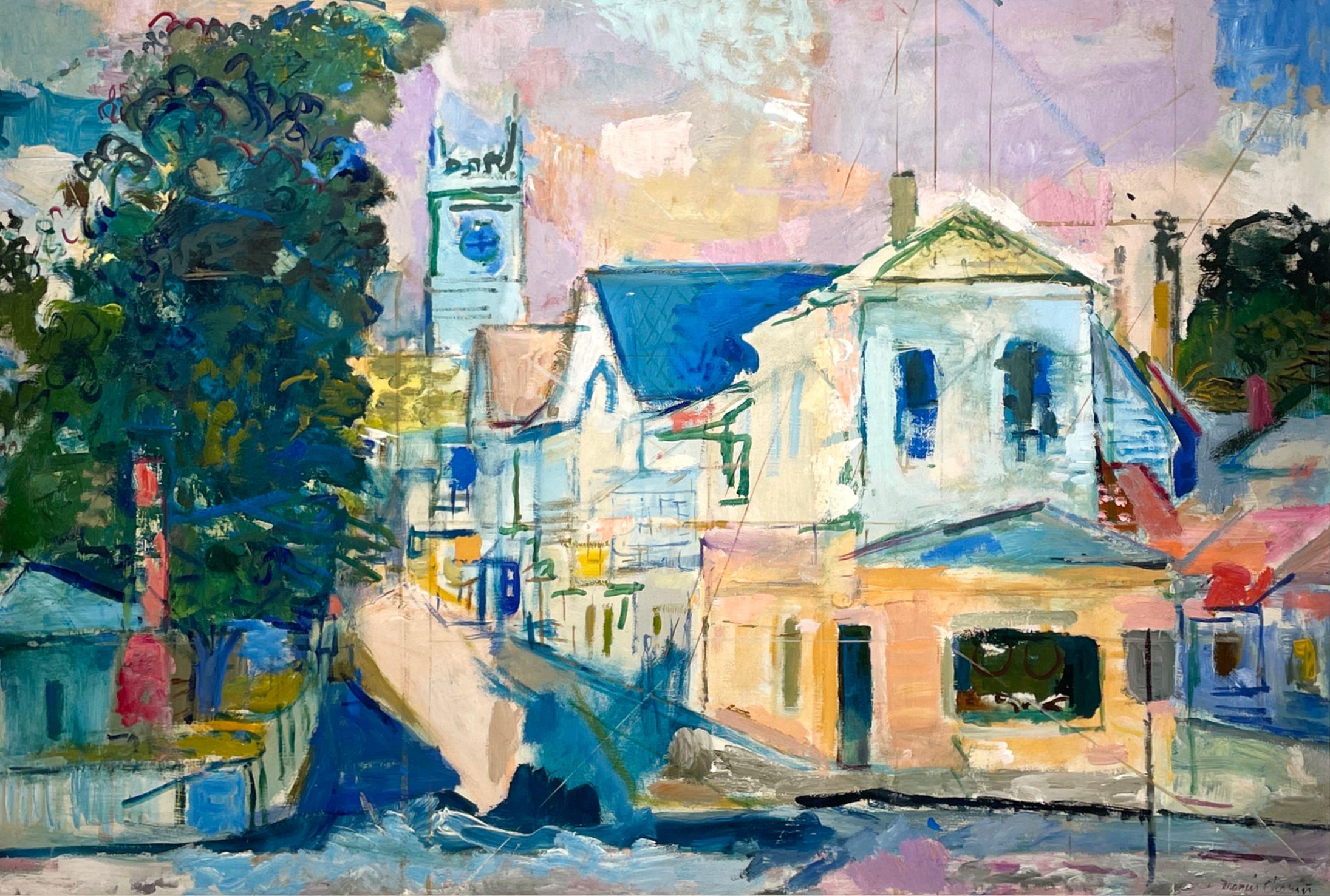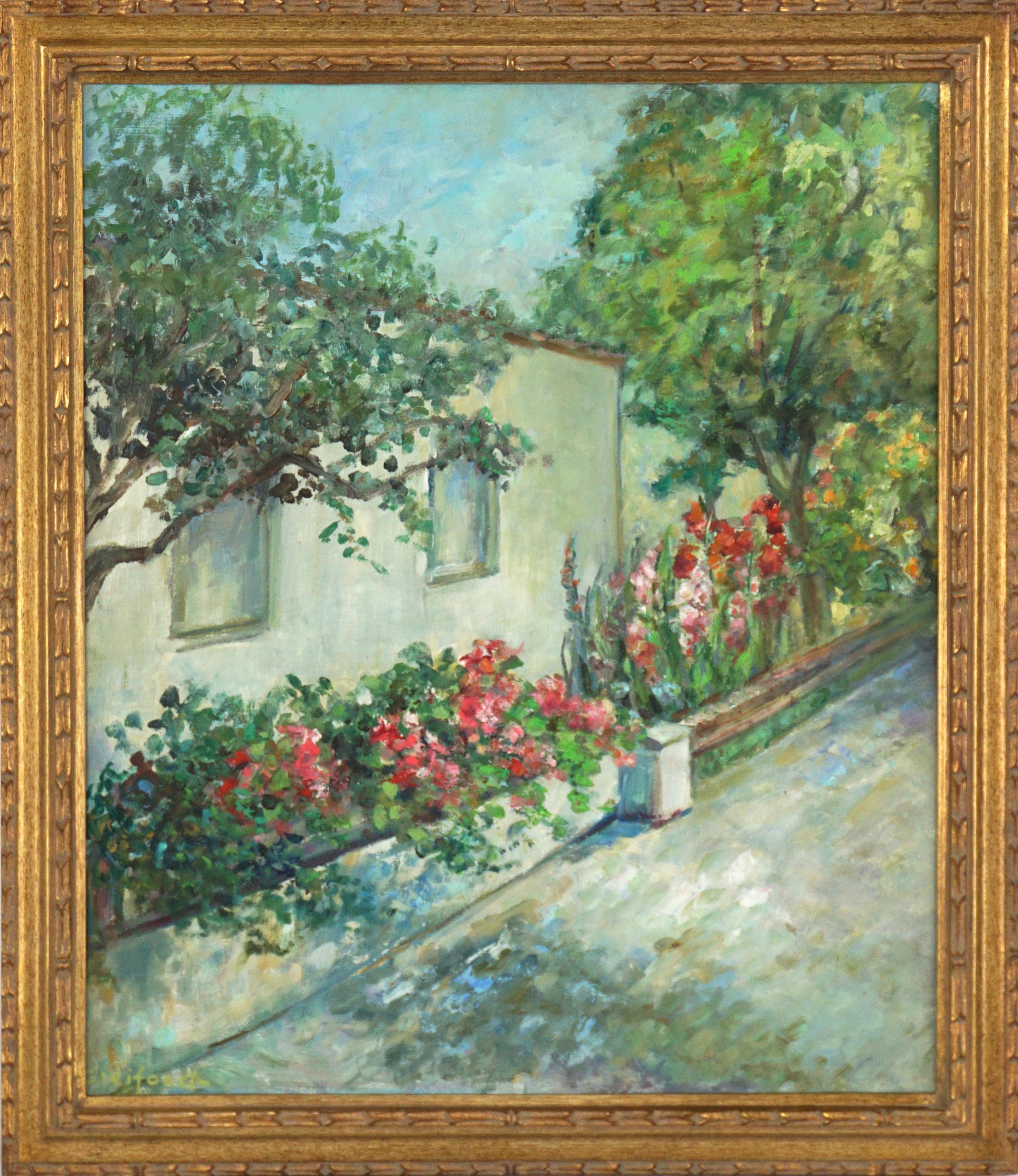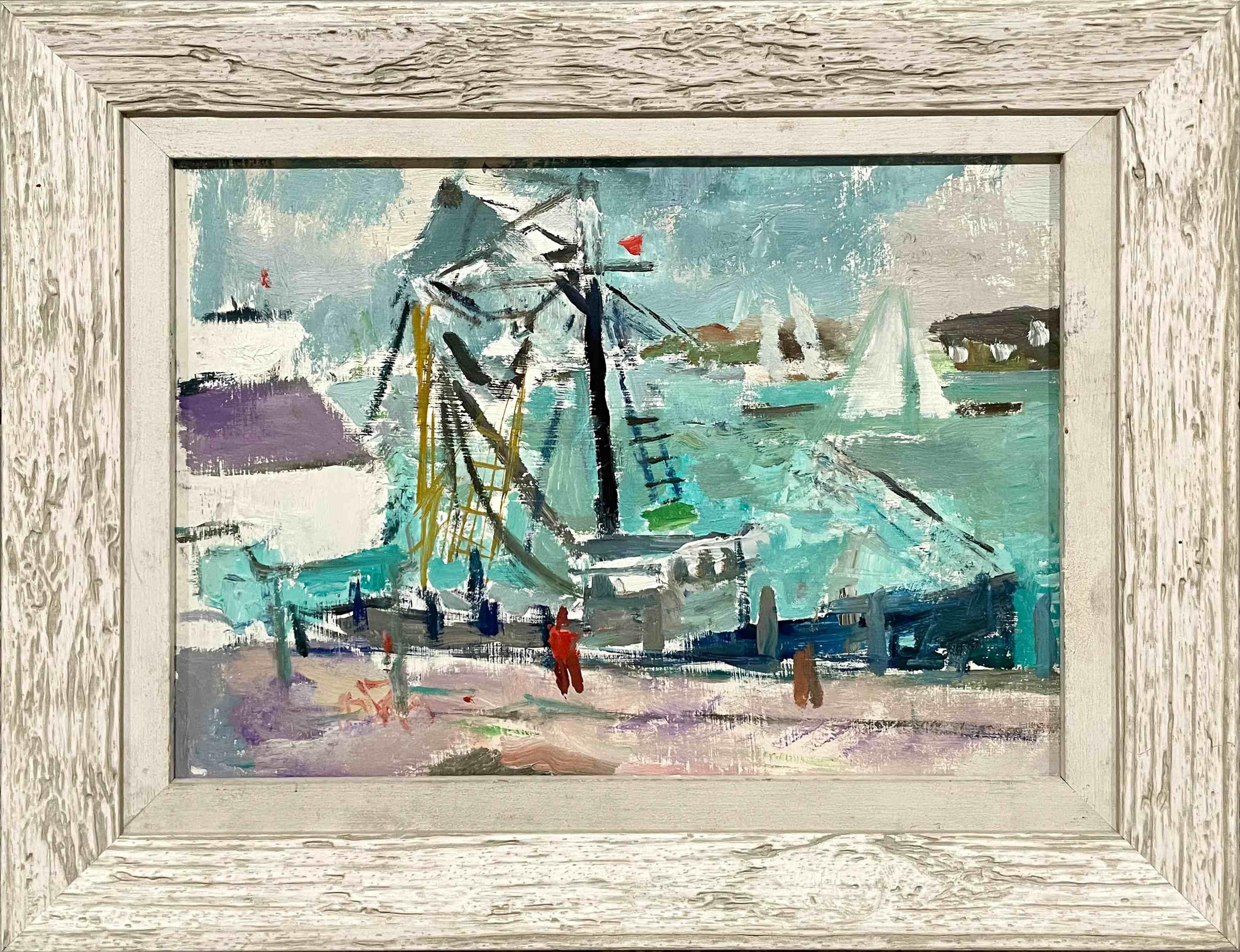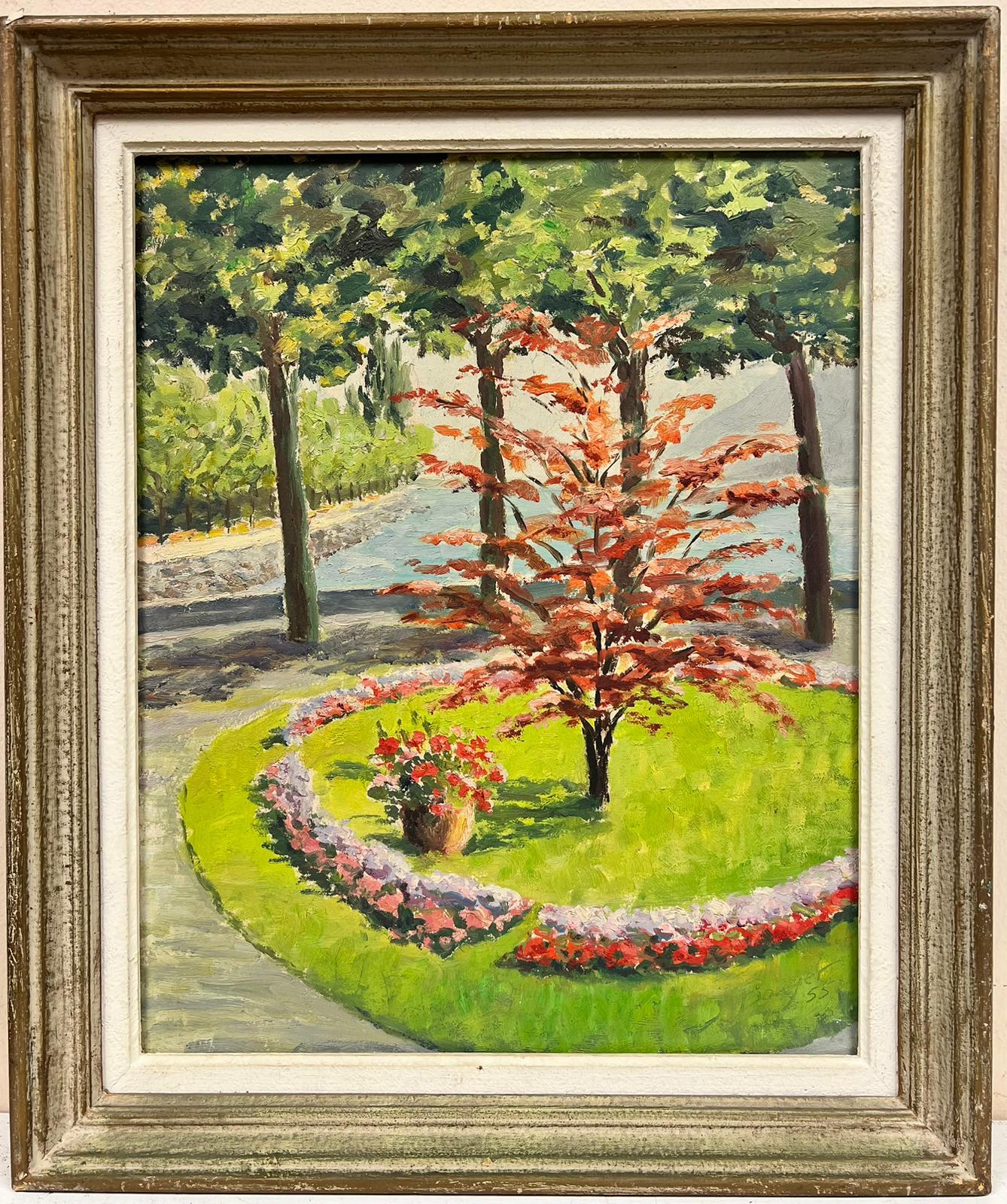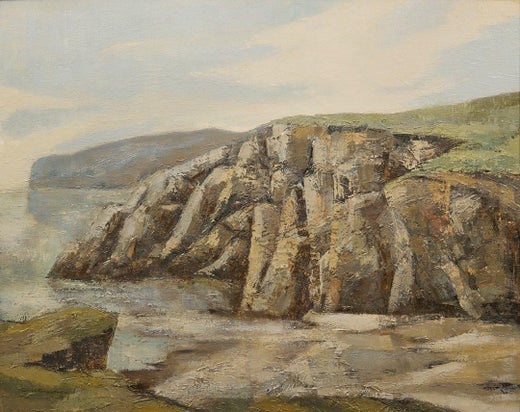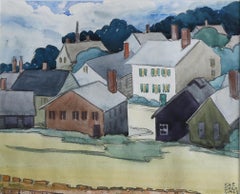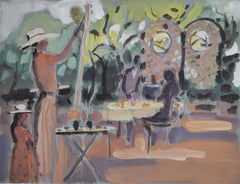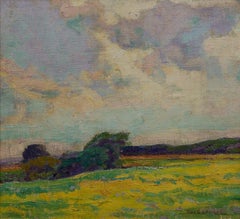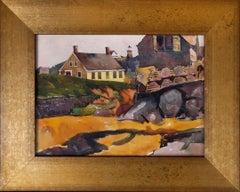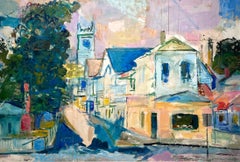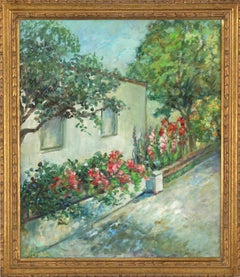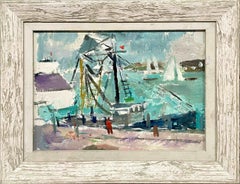Items Similar to Flower Garden, Cape Cod, Mid-Century Cleveland School Painting
Want more images or videos?
Request additional images or videos from the seller
1 of 11
Carl Frederick GaertnerFlower Garden, Cape Cod, Mid-Century Cleveland School Paintingc. 1940s
c. 1940s
$17,050
£13,015.29
€14,961.95
CA$23,992.40
A$26,680.54
CHF 14,013.20
MX$326,196.40
NOK 174,617.88
SEK 164,617.50
DKK 111,664.48
About the Item
Carl Frederick Gaertner (American, 1898-1952)
Flower Garden, Cape Cod, c. 1940s
Gouache on illustration board
17.5 x 29 inches
27 x 39 inches, as framed
Carl Gaertner was one of the greatest painters to emerge from the Cleveland School. Born in Cleveland on April 18, 1898, he graduated from East Technical high school in 1918 and attended Western Reserve College. From 1920 to 1923 he studied at the Cleveland School of Art (now the Cleveland Institute of Art) with Henry Keller. In 1922, he entered his first May Show at the Cleveland Museum of Art and was awarded a prize for an industrial oil painting. From 1925 until 1952, he was known as a pillar of the Cleveland School and one of their most prestigious painting instructors.
Gaertner’s subject matter was always drawn from the world around him. Early in his career, he focused on Cleveland and its environs. This interest never left him, but as he matured, his choice of subjects broadened. He painted watercolors and oils of Bermuda in the mid 1920s and began making frequent trips to Provincetown beginning in the 1920’s. Like other Cleveland artists, he culled inspiration from travels within the United States, notably trips through Pittsburgh’s dramatic industrial landscapes and Cambridge Springs in Pennsylvania, to the mountains of West Virginia, and to Cape Cod. From the mid 1940s until his death, he also produced paintings based on sketches made during train rides to visit galleries in New York City.
At the time of his premature death in 1952, Carl Gaertner enjoyed a considerable reputation as a master of American Scene painting. By the 1940s, Gaertner was represented by the venerable Macbeth Gallery in New York City and his paintings were exhibited in shows throughout the United States. In 1944 and 1952, Gaertner received the National Academy of Design’s highest award for individual work in a group exhibition, and his work was exhibited in the Cleveland Museum of Art’s May Show for 27 years. Gaertner’s works are in the collections of many prestigious institutions, including the Cleveland Museum of Art, the Metropolitan Museum of Art, the Chicago Institute and the Whitney Museum of American Art.
The reflective eye of Gaertner chronicled three decades of Cleveland and the landscapes of the Midwest and its people. It is all there: the growing might of industrial Cleveland; the mass-produced promise of the assembly line, giving way to a dawning awareness of lost freedom and the surrender of individuality; the love affair of Americans with nature and the ideals of Thoreau and Whitman and Frost; and the conflict between that love affair and industrial promise.
Gaertner was just achieving national acclaim at the time of his early death at the age of 54. A resurgence of enthusiasm for Gaertner and his works began in the 1970’s and has steadily increased and incrementally boosted the value of his work, with a fine rare example, “The Popcorn Man” reaching $250,000 at auction.
- Creator:Carl Frederick Gaertner (1898 - 1898, American)
- Creation Year:c. 1940s
- Dimensions:Height: 27 in (68.58 cm)Width: 39 in (99.06 cm)
- Medium:
- Movement & Style:
- Period:
- Condition:
- Gallery Location:Beachwood, OH
- Reference Number:1stDibs: LU176829982232
Carl Frederick Gaertner
Carl Gaertner was one of the greatest painters to emerge from the Cleveland School. Born in Cleveland on April 18, 1898, he graduated from East Technical high school in 1918 and attended Western Reserve College. From 1920 to 1923 he studied at the Cleveland School of Art (now the Cleveland Institute of Art) with Henry Keller. In 1922, he entered his first May Show at the Cleveland Museum of Art and was awarded a prize for an industrial oil painting. From 1925 until 1952, he was known as a pillar of the Cleveland School and one of their most prestigious painting instructors. Gaertner’s subject matter was always drawn from the world around him. Early in his career, he focused on Cleveland and its environs. This interest never left him, but as he matured, his choice of subjects broadened. He painted watercolors and oils of Bermuda in the mid 1920s and began making frequent trips to Provincetown beginning in the 1920’s. Like other Cleveland artists, he culled inspiration from travels within the United States, notably trips through Pittsburgh’s dramatic industrial landscapes and Cambridge Springs in Pennsylvania, to the mountains of West Virginia, and to Cape Cod. From the mid 1940s until his death, he also produced paintings based on sketches made during train rides to visit galleries in New York City. At the time of his premature death in 1952, Carl Gaertner enjoyed a considerable reputation as a master of American Scene painting. By the 1940s, Gaertner was represented by the venerable Macbeth Gallery in New York City and his paintings were exhibited in shows throughout the United States. In 1944 and 1952, Gaertner received the National Academy of Design’s highest award for individual work in a group exhibition, and his work was exhibited in the Cleveland Museum of Art’s May Show for 27 years. Gaertner’s works are in the collections of many prestigious institutions, including the Cleveland Museum of Art, the Metropolitan Museum of Art, the Chicago Institute and the Whitney Museum of American Art. The reflective eye of Gaertner chronicled three decades of Cleveland and the landscapes of the Midwest and its people. It is all there: the growing might of industrial Cleveland; the mass-produced promise of the assembly line, giving way to a dawning awareness of lost freedom and the surrender of individuality; the love affair of Americans with nature and the ideals of Thoreau and Whitman and Frost; and the conflict between that love affair and industrial promise. Gaertner was just achieving national acclaim at the time of his early death at the age of 54. A resurgence of enthusiasm for Gaertner and his works began in the 1970’s and has steadily increased and incrementally boosted the value of his work, with a fine rare example, “The Popcorn Man” reaching $250,000 at auction.
About the Seller
5.0
Platinum Seller
Premium sellers with a 4.7+ rating and 24-hour response times
Established in 1975
1stDibs seller since 2022
37 sales on 1stDibs
Typical response time: <1 hour
- ShippingRetrieving quote...Shipping from: Beachwood, OH
- Return Policy
Authenticity Guarantee
In the unlikely event there’s an issue with an item’s authenticity, contact us within 1 year for a full refund. DetailsMoney-Back Guarantee
If your item is not as described, is damaged in transit, or does not arrive, contact us within 7 days for a full refund. Details24-Hour Cancellation
You have a 24-hour grace period in which to reconsider your purchase, with no questions asked.Vetted Professional Sellers
Our world-class sellers must adhere to strict standards for service and quality, maintaining the integrity of our listings.Price-Match Guarantee
If you find that a seller listed the same item for a lower price elsewhere, we’ll match it.Trusted Global Delivery
Our best-in-class carrier network provides specialized shipping options worldwide, including custom delivery.More From This Seller
View AllNew England Coastal Town Landscape w/ Houses, Cleveland School Woman Artist
Located in Beachwood, OH
Kae Dorn Cass (American, 1901-1971)
New England Coastal Town
Watercolor on paper
Signed lower right
9 in. h. x 11.5 in. w.
17 in. h. x 19 in. w., as framed
Kae Dorn Cass was born...
Category
Mid-20th Century Figurative Drawings and Watercolors
Materials
Watercolor
Outdoor Garden Scene of Woman Painting, Late 20th C. Cleveland Female Artist
Located in Beachwood, OH
Algesa O'Sickey (American, 1917-2006)
Woman Painting
Watercolor and ink on green paper
Unsigned
9 x 12 inches
13.75 x 16 inches, framed
Born Algesa D’Agostino on June 4, 1917, Alges...
Category
Late 20th Century Figurative Drawings and Watercolors
Materials
Ink, Watercolor
Early 20th Century Summer Landscape, Cleveland School Artist
By George Adomeit
Located in Beachwood, OH
George Gustav Adomeit (American, 1879-1967)
Summer Landscape
Oil on canvas board
Signed lower right
13 x 14.25 inches
18.25 x 19.5 inches, framed
A major painter of American scene s...
Category
Early 20th Century American Modern Figurative Paintings
Materials
Oil
Beachside Village, Maine, 20th century landscape watercolor, Cleveland School
By George Adomeit
Located in Beachwood, OH
George Gustav Adomeit (American, 1879-1967)
Beachside Village, Maine
Watercolor on paper
Signed lower right
10 x 14 inches
17.75 x 21.75 inches, framed
A major painter of American ...
Category
Mid-20th Century American Modern Figurative Drawings and Watercolors
Materials
Watercolor
Large Colorful Backyard Landscape Still Life
By Joseph O'Sickey
Located in Beachwood, OH
Joseph B. O’Sickey (American, 1918–2013)
Backyard Landscape
Oil on canvas
Signed lower right
5'10" x 6'7"
Joseph O'Sickey, born in Detroit in 1918, was a painter and teacher through...
Category
20th Century Post-Impressionist Figurative Paintings
Materials
Oil
Cape Ann Coast, Seascape/Landscape Western Massachusetts, Cleveland School
By George Adomeit
Located in Beachwood, OH
George Gustav Adomeit (American, 1879-1967)
Cape Ann Coast, 1922
Oil on canvas
Signed lower left
20 x 24 inches
20.5 x 24.5 inches, framed
A major painter of American scene subjects...
Category
1920s Landscape Paintings
Materials
Oil
You May Also Like
A Charming 1950s Martha's Vineyard Street Scene Painting by Francis Chapin
By Francis Chapin
Located in Chicago, IL
A large & delightful oil on Masonite, ca. 1950s, Martha's Vineyard street scene painting by artist Francis Chapin. Image size: 24" x 36". Framed size: 27" x 37". In a painted woo...
Category
1950s American Modern Landscape Paintings
Materials
Masonite, Oil
Mid Century Carmel Cottage with Flowers Landscape
By Helen Enoch Gleiforst
Located in Soquel, CA
Charming mid century painting of Carmel stucco cottage and with gladiolas and Geraniums in planting beds by listed artist Helen Enoch Gleiforst (American,...
Category
Mid-20th Century American Impressionist Landscape Paintings
Materials
Masonite, Oil
$1,480 Sale Price
20% Off
"Wellfleet, Cape Cod, " Gerrit Beneker, American Impressionism, Provincetown
By Gerrit Beneker
Located in New York, NY
Gerrit Beneker (1882 - 1934)
Wellfleet, Cape Cod, Massachusetts, New England, 1926
Oil on canvas
20 x 16 inches
Signed, titled, and dated lower left
Provenance:
Louis H. Barnett, Fort Worth, Texas
In 1905, Gerrit Beneker began his art career as an illustrator. He married Flora Judd, his high school sweetheart from Grand Rapids and they moved to Brooklyn, NY. Gerrit's early passion was to create an art that would inspire and provide honor to the workingman. As such, he had no interest in painting portraits of pretty women, which were so often seen on the magazine covers of the day. Rather he wanted to seek out workingmen on the bridges, tunnels and skyscrapers of NYC, and paint them in their environments. He completed over 150 magazine covers, numerous ads including many for Ivory Soap...
Category
1920s American Impressionist Landscape Paintings
Materials
Canvas, Oil
A Charming 1950s Mid-Century Modern Harbor Scene of Martha's Vineyard
By Francis Chapin
Located in Chicago, IL
A Charming 1950s Mid-Century Modern Harbor Scene of Martha's Vineyard by Notable Chicago Artist, Francis Chapin (Am. 1899-1965). Completed near the artist's studio and summer home in the historic whaling port town of Edgartown, Massachusetts; a cheerful, diminutive painting of a busy sunlit boat dock. Artwork size: 8 3/4" x 11 3/4". Framed size: 12 1/2" x 15 1/2". Estate stepped on reverse. Provenance: Estate of the artist.
Francis Chapin, affectionately called the “Dean of Chicago Painters” by his colleagues, was one of the city’s most popular and celebrated painters in his day. Born at the dawn of the 20th Century in Bristolville, Ohio, Chapin graduated from Washington & Jefferson College near Pittsburgh, Pennsylvania before enrolling at the Art Institute of Chicago in 1922. He would set down deep roots at the Art Institute of Chicago, exhibiting there over 31 times between 1926 and 1951. In 1927 Chapin won the prestigious Bryan Lathrop Fellowship from the Art Institute – a prize that funded the artist’s yearlong study trip to Europe. Upon his return to the United States, Chapin decided to remain in Chicago, noting the freedom Chicago artists have in developing independently of the pressure to conform to pre-existing molds (as was experienced by artists in New York, for example). Chapin became a popular instructor at the Art Institute, teaching there from 1929 to 1947 and at the Art Institute’s summer art school in Saugatuck, Michigan (now called Oxbow) between 1934 – 1938 (he was the director of the school from 1941-1945).
A prolific painter, Chapin produced numerous works while traveling in Mexico, France, Spain, Saugatuck and Martha’s Vineyard, where he frequently spent summers and taught at the Old Sculpin Gallery there. Chapin was best recognized for his dynamic and vibrant images of Chicago during the 1930s and 40s. Chapin was a resident of the Old Town neighborhood where he lived and kept his studio on Menomonee Street for many years. Described as a “colorful figure, nearly 6 feet 6 inches tall, and thin, and usually wearing tweeds”, it is easy to imagine Chapin at work observing the busy street life of the city.
In addition to his many exhibitions at the Art Institute of Chicago, Chapin’s work was shown during his lifetime at such institutions as the Pennsylvania Academy of Fine Arts, Philadelphia; the Corcoran Gallery, Washington, D.C.; the National Academy of Design, New York; the Museum of Modern Art, New York; the Whitney Museum of American Art, New York and the Carnegie Institute, Pittsburgh, among others. Francis Chapin’s paintings are represented in the collections the Art Institute of Chicago; the Friedman Collection, Chicago; the Butler Institute of American Art, Youngstown; the Denver Art Museum; the Everson Museum of Art, Syracuse; the Norton Museum of Art, West Palm Beach...
Category
Mid-20th Century American Modern Landscape Paintings
Materials
Masonite, Oil
1950's French Impressionist Signed Oil Flower Garden overlooking the Coast
Located in Cirencester, Gloucestershire
Artist/ School: French School, signed and dated 55
Title: The Flower Garden
Medium: oil on board, framed
Framed: 19 x 16 inches
Size: 16 x 13 inches
Colors: Green colors, pink, r...
Category
Mid-20th Century Impressionist Landscape Paintings
Materials
Oil
"Holicong Garden"
By Joseph Barrett
Located in Lambertville, NJ
Illustrated in "Joseph Barrett, The Prime Years 1970s - 1990s", pg. 61, plate #071.
Jim’s of Lambertville is proud to offer this artwork by:
Joseph Barrett (1936 – )
Joseph B...
Category
Late 20th Century American Impressionist Landscape Paintings
Materials
Canvas, Oil
More Ways To Browse
Mid Century Flower Art
Mid Century Oil Painting Flower
Codor Design
Bermuda Painting
Cambridge 1920s
Bernard Krigstein
Betty Lane
Camille Roqueplan
Carlos Rancano
Carol Reeves
Charlie Mackesy
Christian Wilhelm Ernst Dietrich
Cream Of Wheat Advertising
De Boer
Dean Fox
Durer Rhino
Edward Corbett Painting
Edward Sultan
